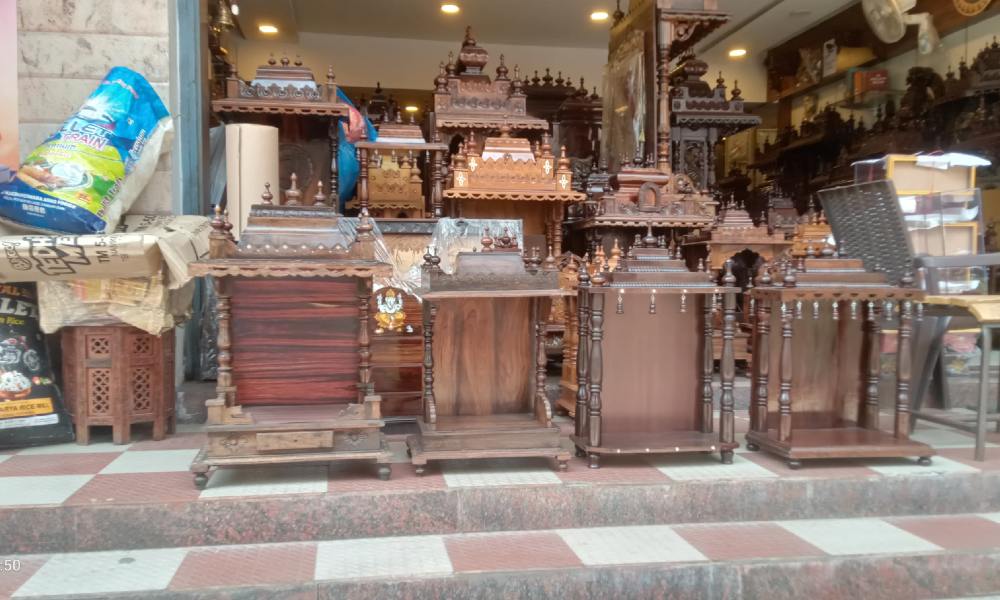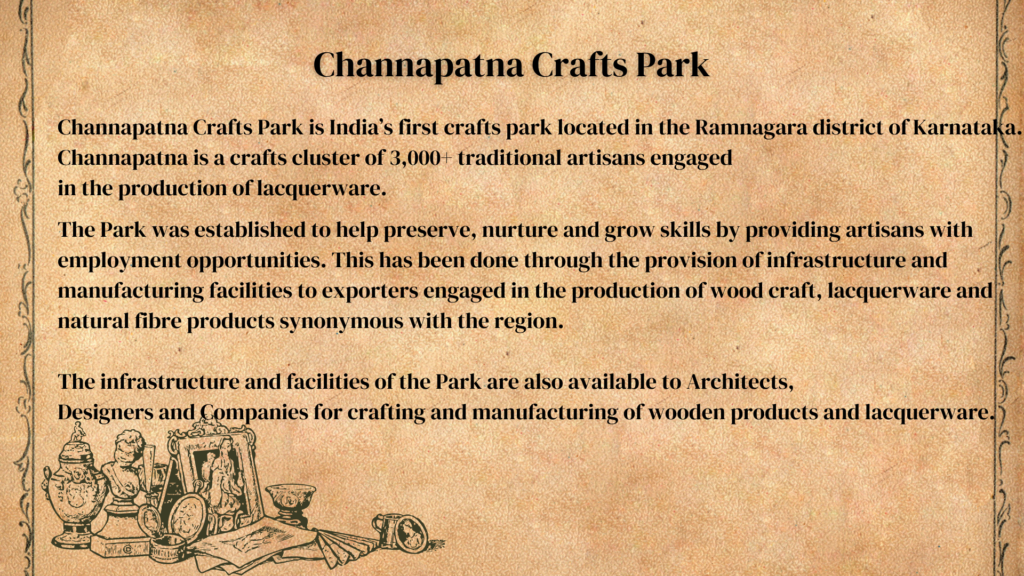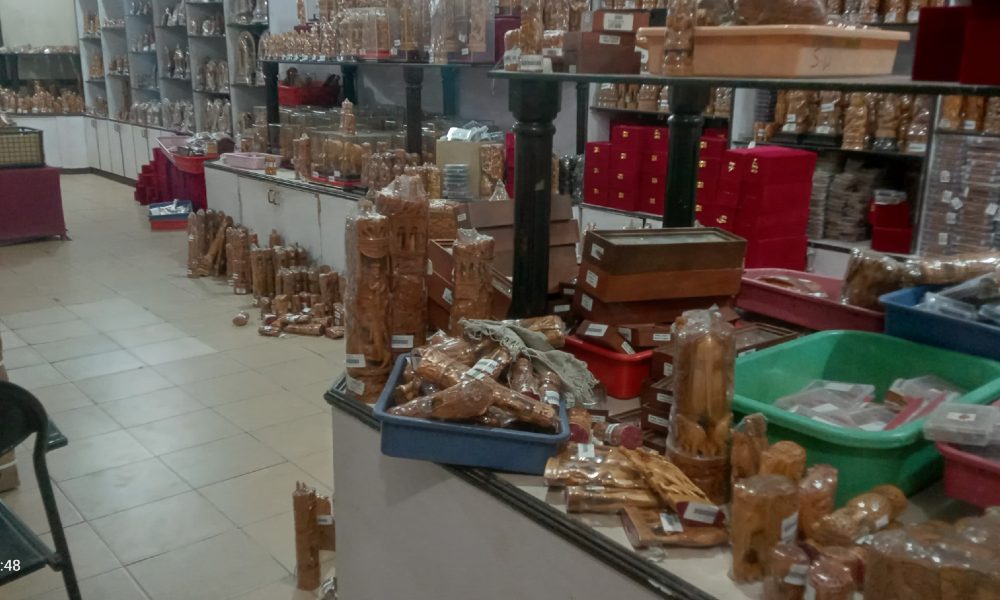The wooden handicrafts industry in the state is gradually losing ground and prominence; experts reason loss of artisans, arising from lack of raw material due to diminishing forest cover.
When you walk in, the woody smell engulfs you. The intricate designs on the various show pieces and craft work captivates your heart. However, the price tag on a piece could potentially take you by surprise. The staff and manager at Cauvery Emporium, MG Road say that the prices of wooden handicrafts items at the store have risen significantly over the last two years, one reason for which is the scarcity of raw materials.
Khadir, owner of Metro Cane Arts in Malleshwaram, and an artisan himself, said that although the demand for handicrafts at his shop is steady, it is becoming increasingly difficult to increase their supply due to a shortage of raw wood. He said the prices of wood at sawmills were becoming costlier and that the cost of importing from other states is also higher now compared to five years ago. “Only manufacturers and artisans with enough capital can afford to buy wood at such high prices. We are struggling,” he added.
Inayath, owner of Inayath Cane Furniture Works, also in Malleshwaram, said they procure raw wood (cane) from places like Kinhal and Karwar. He surmised that in the past two years the price of wood has gone up by 70 percent. He added that due to increasing costs, they are unable to pay the artisans well which has made many to leave woodworking and consider other professions. “If wood were available in plenty and for cheap, the handicraft businesses could perform much better,” he said.
Both Khadir and Inayath said they have not listed themselves under the Karnataka State Handicrafts Development Corporation and do not receive subsidies while buying raw materials. They agreed that there is restricted freedom of creativity while working for the government, as the design outlines are decided by the former. Additionally they have inherited the family business, they said.
About 78.3 percent and 90.7 percent of wooden handicraft artisans in the 21-50 and 51-80 year age groups respectively agree on the scarcity of wood as raw material, according to a 2023 survey conducted by the Environmental Management and Policy Research Institute (EMPRI). The total demand for raw wood by the artisans registered at the four handicraft service centers in the state is around 4,120 cubic meters, whereas the availability is 3,229 cubic meters, leaving a supply gap of 891 cubic meters (21.6 percent) the survey further finds. It should be noted that the gap recorded here was by surveying artisans at the handicraft service centers only and not all artisans.
EMPRI falls under the Department of Forest, Ecology, and Environment, Government of Karnataka. The survey which sought to gauge the status of wooden handicrafts in the state, found that one of the major impediments to the growth of the sector was the inconsistent availability of raw wood.
M Mandal, marketing-in-charge of the Karnataka State Handicrafts Development Corporation Ltd. (KSHDCL), attributed the shortage of raw wood to overexploitation of woods. He added that the Karnataka Tree Preservation Act, 1976 has made timber procurement difficult as the act ensures protection or regulation of felling of trees in private and non-forest lands.
The restrictions on export of Sheesham (Indian rosewood) products were imposed under the Convention on International Trade in Endangered Species (CITES). Such a decision affected the country’s furniture and handicrafts industry. However, the government revised the restrictions and at present, every consignment of handicrafts and furniture weighing above 10 kilograms requires a CITES permit. However, this revised restriction has also caused losses in this industry.
N Narayana Murthy, manager at the Cauvery Emporium, which is the exhibition-cum-sale wing of the KSHDCL said rosewood, sandalwood, saguvani, mahogany and kadamba wood are the main types of wood used to make handicrafts. He added that rosewood and sandalwood items are the most demanded items in the store.
Mandal said that wood for handicrafts is mainly supplied by the Karnataka Forest Department (KFD), private farmlands, and import from other states. He added that over the years, the supply of rosewood and sandalwood for artisans from the KFD has reduced. “This is possibly because of lack of quality wood set aside for other reasons, such as medicine, furniture or exports,” he said.

Mandal also said more than 4,500 artisans are registered with the KSHDCL and over 50,000 artisans are indirectly dependant on the corporation for exercising and promoting their craftsmanship. “Raw materials such as sandalwood, silver and zinc are provided at subsidized rates to artisans,” he added.
However, according to the EMPRI report, the total requirement for a thousand sandalwood craftsmen in the state would be around 100 tonnes a year, but the KSHDCL can meet barely 10 percent of the demand.
Another official from the KSHDCL said that new artisans are currently not being listed under the KSHDCL, due to the non-availability of raw wood, especially sandalwood, the demand for which is the highest.
Nagananda G P, owner of Gatti Handicrafts in Malleshwaram was of the opinion that handicrafts industries cannot compete with construction companies in e-auction of wood as construction companies purchase wood in bulk. For example, construction companies might buy bamboo in bulk, but artisans crafting handicrafts from bamboo might not need that much bamboo, he explained.
Viswanath Nayak, owner of Mahalsa Designer Doors, in Ashok Nagar said that he is not satisfied with the quality of wood supplied by private farms because they do not satisfy the requirement for the kind of wood needed for hand-carving. He added that earlier, parts of wood would be used to make colour gradients in crafts, but now dyes have replaced wood, due to its short supply and increasing costs.

The livelihoods of artisans who work in Channapatna’s wooden toy industry (in the Ramnagara district of Karnataka) have been impacted because of the Bengaluru-Mysuru expressway that does not connect to the toy factory according to news reports. The factory largely depends on tourists visiting for their business.
The EMPRI report states that the sale of handmade products has witnessed a downward trend. It suggests more structured intervention and assistance from the government, private funding including Corporate Social Responsibility (CSR) opportunities, as necessary to maintain and revive the handicrafts industry.
S Shashikala, Assistant Chief Technical Officer at Institute of Wood Science and Technology, Bangalore said that the overexploitation of wood for various purposes have led to the scarcity of wood for handicrafts. She invoked the implementation of the Wildlife (Protection) Act, due to which, crafters involved craft-making from elephant ivory and deer antlers had to shift to wood species which caused a spike in the demand for raw wood.
“To fill the demand gap, government forests need to be expanded. The number of privately grown trees under social or agroforestry schemes to supply wood has to be increased,” she suggested. “Policy level changes need to be brought about,” she said.

She was also of the opinion that due to reduced availability of woods traditionally used for handicrafts, certain new woods could be considered if found as good substitutes. The EMPRI report lists earpod wattle, sheesham, neem, cinnamon and genthi as some of such substitutes.
She believed that providing raw materials at subsidized rates to both self-employed artisans and those working with the government on a continuous basis will be helpful. “The KSHDCL should encourage the farmers to grow tree species required for handicrafts. The corporation may also exempt tax on raw material while selling it to artisans and also on purchase of finished goods from artisans,” she suggested.




